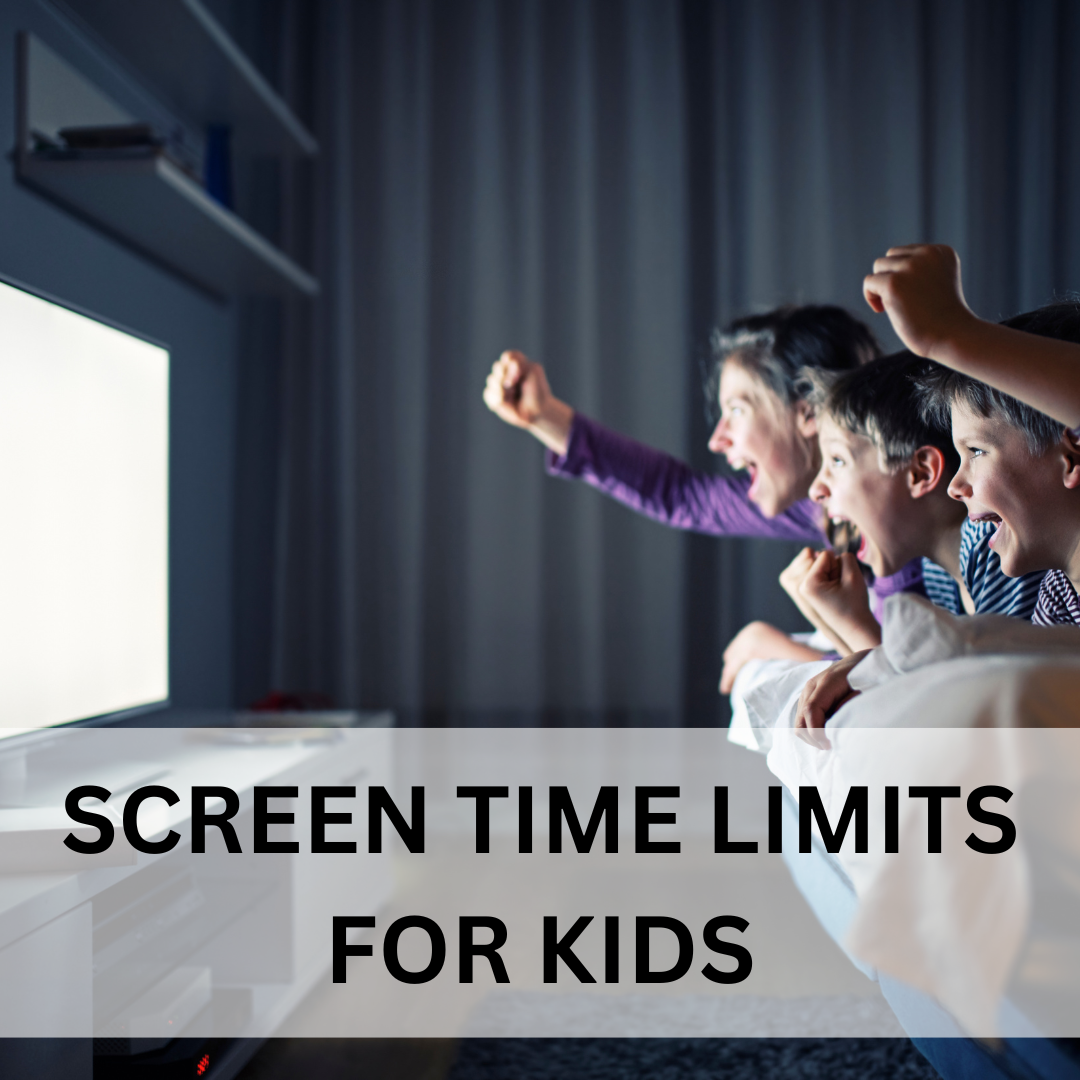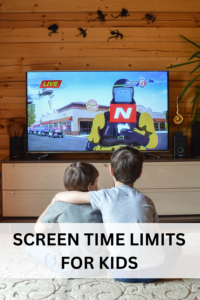
This detailed guide provides parents with age-appropriate screen time limits for kids, grounded in child development principles and supported by expert recommendations.
In the contemporary landscape, screens are ubiquitous, ranging from smartphones and tablets to televisions and computers. They serve various purposes, from education and entertainment to communication and information.
While technology offers numerous benefits, managing screen time for children is critical to ensure it supports their development rather than impeding it.

Hi! My name is Marra and I’m a mama and a pediatric occupational therapist who has years of experience working with children with diverse developmental needs and helping their parents navigate the ups and downs of child development.
I loved being a support person for parents learning about child development, sensory processing, and their child’s individual needs.
The topic of screen time limits for kids would often come up in my discussions with parents and how it relates to their child’s development. I would always take a holistic approach when making recommendations for screen time for their kids because every child is different.
That being said their are some general rules I would always follow and I wanted to share them with all of you. This post is all about age-appropriate screen time limits for kids.

THE IMPORTANCE OF SETTING SCREEN TIME LIMITS FOR KIDS
Excessive screen time can have several adverse effects on children. As stated before, every child is different and has their own unique developmental needs. These are just a few things to look out for when considering screen time limits for kids.
- Sleep Disturbances: Blue light from screens can disrupt sleep patterns and circadian rhythms, leading to inadequate sleep which is essential for growth and cognitive development.
- Obesity: Sedentary behavior associated with prolonged screen time can contribute to obesity and related health issues.
- Behavioral Problems: Overexposure to screens, especially content with violent or inappropriate themes, can influence behavior negatively.
- Decreased Social Skills: Excessive screen time can limit opportunities for face-to-face interactions, crucial for developing social skills and emotional intelligence.
Conversely, appropriate and minimal screen use can enhance learning, provide valuable information, and even improve social connections when used correctly. Thus, understanding and enforcing balanced screen time limits for kids is key.

Screen Time limits for kids:
Guidelines by Age
Infants (0-18 months)
Recommendation: Avoid Screen Time, Except for Video Chatting
For infants, direct interaction with caregivers and the environment is fundamental. Screen exposure at this age can interfere with vital activities such as bonding, sensory exploration, and motor skill development.
- Developmental Focus: During this stage, infants are rapidly developing their brains. Sensory exploration and interaction with caregivers help build neural connections and support emotional bonds.
- Guideline: The American Academy of Pediatrics (AAP) advises against any screen time for infants under 18 months, except for video chatting to maintain family connections. This activity should be facilitated by caregivers to ensure that it is a shared experience, enhancing its emotional and social benefits.
Toddlers (18-24 months)
Recommendation: Introduce High-Quality, Age-Appropriate Media, 30 minutes a day or less
Toddlers start to develop language and cognitive skills rapidly. Limited, carefully chosen screen time can be beneficial if it involves high-quality content designed for their developmental stage.
- Developmental Focus: At this age, language acquisition and cognitive development are critical. Interactive and educational content can aid in learning new words and concepts.
- Guideline: If parents choose to introduce digital media, it should not exceed 30 minutes per day and should always involve co-viewing with a caregiver. This ensures that the child understands and engages with the content, turning it into an active learning experience rather than passive consumption.

Preschoolers (2-5 years)
Recommendation: Limit Screen Time to 1 Hour Per Day
Preschoolers are highly impressionable and benefit most from activities that promote imagination, physical play, and direct interaction with peers and adults.
- Developmental Focus: Imagination, socialization, and emotional regulation are key at this stage. Engaging in pretend play, physical activities, and interacting with others helps build these skills.
- Guideline: Limit screen time to one hour per day of high-quality programming. Parents should co-view to help children understand the content and apply it to the real world. Interactive media that encourages participation rather than passive watching is preferred.
School-Age Children (6-12 years)
Recommendation: Balance Screen Time with Physical and Social Activities
School-age children develop more sophisticated cognitive skills and are increasingly influenced by their peers. Educational screen time can complement learning but should not replace physical activity or face-to-face interactions.
- Developmental Focus: Academic skills, social relationships, and physical health are primary focuses during this stage. Children learn best through a combination of structured education and unstructured play.
- Guideline: Set consistent limits on screen time, aiming for no more than 2 hours per day of recreational screen time, excluding educational activities. Encourage a healthy balance with homework, physical play, and family activities. Use of screens for educational purposes should be monitored to ensure it is productive and not just a guise for entertainment.

Teenagers (13-18 years)
Recommendation: Encourage Self-Regulation and Healthy Habits
Teenagers are more autonomous and use screens for education, socializing, and entertainment. Guiding them in developing self-regulation skills and healthy screen habits is essential.
- Developmental Focus: Identity formation, independence, and responsible decision-making are crucial during adolescence. Teenagers should be encouraged to think critically about their screen use and its impact on their lives.
- Guideline: While there is no one-size-fits-all limit, it is important for parents to encourage teens to self-regulate and maintain a healthy balance. Discuss the purpose and impact of screen time, ensuring it doesn’t interfere with sleep, physical activity, or real-life social interactions. Encourage activities that involve face-to-face interaction and physical exercise.

Detailed Strategies for Managing Screen Time Limits for Kids
Model Healthy Screen Habits:
- Parents as Role Models: Children often mimic adult behavior. Demonstrating balanced and mindful screen use helps set a positive example. Avoid excessive screen time in front of children and prioritize face-to-face interactions and physical activities.
Create Tech-Free Zones and Times:
- Establish Tech-Free Zones: Designate specific areas in the home, such as dining rooms and bedrooms, as screen-free zones to promote family interaction and ensure better sleep.
- Set Tech-Free Times: Implement tech-free times, such as during meals and one hour before bedtime, to encourage conversation and relaxation without digital distractions.
Encourage Alternative Activities:
- Physical Activities: Promote outdoor play, sports, and other physical activities that keep children active and healthy.
- Creative Play: Encourage hobbies like drawing, reading, building with blocks, and imaginative play that foster creativity and critical thinking.
- Family Activities: Engage in activities that involve the whole family, such as board games, cooking together, or taking walks, to strengthen family bonds and reduce reliance on screens.
Set Clear Rules and Consistency:
- Establish Screen Time Rules: Have clear guidelines about when and how screens can be used. For instance, screen time can be allowed after homework is completed or as a reward for chores.
- Be Consistent: Consistency in enforcing these rules helps children understand the importance of balance and discipline in screen use.
Use Parental Controls:
- Monitor and Manage Screen Use: Utilize parental control tools to manage and monitor your child’s screen time and ensure the content is age-appropriate. Many devices and apps offer settings that allow parents to set limits and track usage.
- Educational Apps: Opt for educational apps and programs that offer interactive learning experiences, reinforcing what children learn in school and expanding their knowledge.
Be Involved and Engaged:
- Co-View and Discuss: Co-view programs and digital content with your children to help them understand and critically evaluate what they are seeing. Discuss the content and relate it to real-life experiences to enhance understanding and learning.
- Encourage Critical Thinking: Teach children to think critically about the media they consume. Discuss the difference between advertising and reality, and encourage them to question the content they see.
Foster Digital Literacy:
- Teach Responsible Use: Educate children about responsible screen use, including the importance of privacy, understanding digital footprints, and being respectful online.
- Digital Skills: Help children develop digital skills that are essential in the modern world, such as typing, researching, and using technology for educational purposes.
While screens are an inescapable part of modern life, mindful and moderated use can support rather than hinder child development.
By setting appropriate screen time limits for kids based on age and developmental stage, parents can help their children cultivate healthy habits and maximize the benefits of technology while minimizing its potential downsides.
The goal is not to eliminate screens but to integrate them in a way that supports holistic growth and development.
Balancing screen time with physical activity, social interaction, and other enriching experiences ensures that children develop well-rounded skills and maintain their physical and mental health.
Through thoughtful guidance and active involvement, parents can help their children navigate the digital world safely and effectively.
